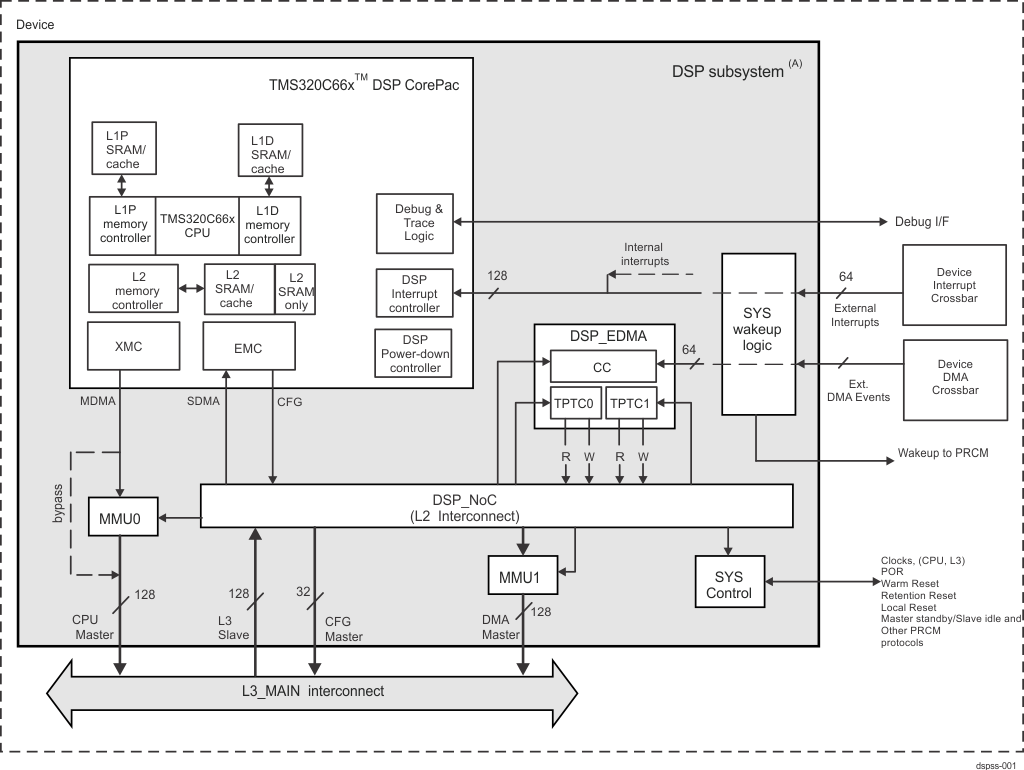SPRAC21A June 2016 – June 2019 OMAP-L132 , OMAP-L138 , TDA2E , TDA2EG-17 , TDA2HF , TDA2HG , TDA2HV , TDA2LF , TDA2P-ABZ , TDA2P-ACD , TDA2SA , TDA2SG , TDA2SX , TDA3LA , TDA3LX , TDA3MA , TDA3MD , TDA3MV
-
TDA2xx and TDA2ex Performance
- Trademarks
- 1 SoC Overview
- 2 Cortex-A15
- 3 System Enhanced Direct Memory Access (System EDMA)
- 4 DSP Subsystem EDMA
- 5 Embedded Vision Engine (EVE) Subsystem EDMA
- 6 DSP CPU
- 7 Cortex-M4 (IPU)
- 8 USB IP
- 9 PCIe IP
- 10 IVA-HD IP
- 11 MMC IP
- 12 SATA IP
- 13 GMAC IP
- 14 GPMC IP
- 15 QSPI IP
- 16 Standard Benchmarks
- 17
Error Checking and Correction (ECC)
- 17.1 OCMC ECC Programming
- 17.2 EMIF ECC Programming
- 17.3 EMIF ECC Programming to Starterware Code Mapping
- 17.4 Careabouts of Using EMIF ECC
- 17.5 Impact of ECC on Performance
- 18 DDR3 Interleaved vs Non-Interleaved
- 19 DDR3 vs DDR2 Performance
- 20 Boot Time Profile
- 21 L3 Statistics Collector Programming Model
- 22 Reference
- Revision History
6 DSP CPU
C66x CorePac is the name used to designate the hardware that includes the following components: TMS320C66x DSP, Level 1 program (L1P) memory controller, Level 1 data (L1D) memory controller, Level 2 (L2) memory controller, Internal DMA (IDMA), external memory controller (EMC), extended memory controller (XMC), bandwidth management (BWM), interrupt controller (INTC) and power down controller (PDC).
The TMS320C66x DSP CorePac memory components include:
- A 32-KiB L1 program memory (L1P) configurable as cache and / or SRAM. When configured as a cache, the L1P is a 1-way set-associative cache with a 32-byte cache line
- A 32-KiB L1 data memory (L1D) configurable as cache and / or SRAM. When configured as a cache, the L1D is a 2-way set-associative cache with a 64-byte cache line
- A 288-KiB (program and data) L2 memory, only part of which is cacheable. When configured as a cache, the L2 memory is a 4-way set associative cache with a 128-byte cache line. Only 256 KiB of L2 memory can be configured as cache or SRAM. 32 KiB of the L2 memory is always mapped as SRAM.
The C66x DSP CorePac block in the DSP subsystem is shown in Figure 19.

This section describes the DSP CPU read-write performance with no other traffic in the system. The three operations that the bandwidth is measured for are: a pipelined copy from source to destination buffer, pipeline read from the source buffer and pipelined write to the destination buffer. The CPU data path in the DSP Subsystem is from the CorePac XMC to the WC, optionally through the MMU0 and out of the DSP subsystem through the MDMA port.